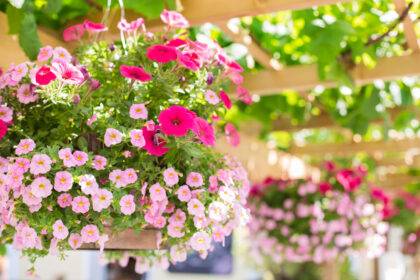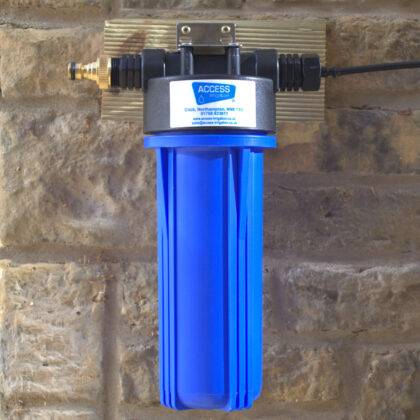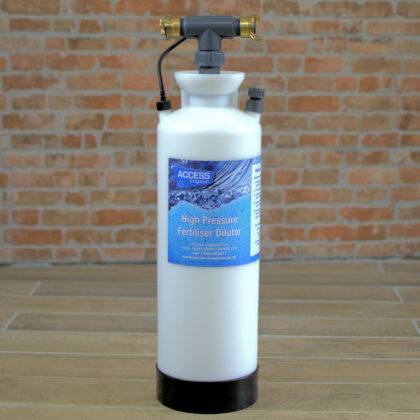Water is essential for plants but sometimes they need a boost that water alone can’t provide. Plants can get goodness directly from the soil, but they may need extra help, especially during the growing season. Feeding plants with a hose fertiliser feeder as an easy method of adding fertiliser to give a kickstart to most plants especially those in restricted soil situations such as hanging baskets or pots. The time of year is also a key factor in choosing when to feed your plants. Plant growth will occur in the Spring and Summer months.
Plant feed

Plant feed (fertiliser) contains a concentrated amount of beneficial nutrients. The exact make up is usually termed as numbers (percentages) and letters N-P-K which are the three essential ingredients.
- (N) Nitrogen – promotes leaf growth.
- (P) Phosphorus – promotes strong roots.
- (K) Potassium – promotes fruit and flowers.
Where NPK ratios are the same this is called a balanced or general fertiliser. Where the numbers are different, the fertiliser is designed to target a specific type of crop. Always check for a suitable mix for what you are trying to grow. Most Garden Centres have a special section on feeds and fertilisers with helpful guidance.
Fertilisers can be applied in different ways, so come in many forms commonly Granular, Pellets, Powder and Liquid. The former two are designed to be applied directly, the latter two as a pre-mix and applied via hose end feeder or dilutor.
Benefits of using liquid feed
Feeding plants with liquid fertiliser offers a range of compelling benefits for gardeners, growers, nurseries and farmers alike.
- Quick Nutrient Absorption: Liquid fertilisers are readily available to plants, allowing for swift nutrient absorption through both foliar (leaf) and root uptake. This results in faster growth and improved plant health.
- Precision Feeding: Liquid fertilisers are highly customizable, enabling growers to tailor nutrient mixes to their plant’s specific needs. This precision helps address nutrient deficiencies and optimises plant growth.
- Even Distribution: Liquid fertilisers can be easily applied uniformly across a plant’s entire surface, ensuring every part receives adequate nourishment. This consistency leads to balanced growth and healthier plants.
- Reduced Environmental Impact: Liquid fertilisers are less likely to leach into groundwater compared to granular fertilisers, reducing the risk of water pollution and minimising the environmental footprint of agriculture.
- Versatility: Liquid fertilisers can be used in various ways, from drip irrigation to foliar spraying, making them suitable for a wide range of crops and gardening practices.
- Rapid Response: Liquid fertilisers can provide a quick response to nutrient deficiencies or stress conditions, helping plants recover more rapidly.
- Convenient Application: Liquid fertilisers are easy to handle and mix, simplifying the fertilisation process for both small-scale gardeners and large-scale agricultural operations.
Hose Fertiliser Feeders
Hose End Feeders or Garden Hose Feeders as they are sometimes called, simply connect onto the end of your hose. Basic versions are non-adjustable and the fertiliser is usually feeder specific. The more sophisticated types are Water to Feed Ratio adjustable these offer a greater variety of fertiliser choices.
Our range of hose end feeders provide a cost-effective method of applying fertiliser. They have no moving parts and are easy to set up and use.
Feeding hanging baskets

The Hanging Basket Feeder AFBP is an example of the basic type. It has a replaceable cartridge which contains a slow-release granular fertiliser. The cartridge system allows the feeder to operate with low flow, such as a few hanging basket systems in the garden.
The housing is designed to connect onto a hose, or it can be connected onto a small-bore pipe as used in hanging basket or pot irrigation systems, taking the feed to the heart of the basket. Simply replace the cartridge twice during the growing season.
Feeding larger areas of the garden

The other feeders or dilutors in our range are examples of a Water to Feed Ratio adjustable type. These are designed to water much larger areas of the garde, where using a watering can with a fertilise mix would be time consuming and laborious. Available as a static and mobile model. The static model ADS comes with interchangeable jets so you can choose how much water you treat. As the water sits on top of the chemical it must not be disturbed or left for a long period. The ADMP is our professional model, again this has interchangeable jets but also an inner bag which separates the chemical from the water which means it can be moved and left overnight.
To operate these models, the bottle is filled with a concentrated fertiliser and as the water flows through the metering head it draws up some of the concentrate, providing the right feed ratio at the outlet. These dilutors can be used with watering lances or spray guns, or connected to sprinklers for watering larger lawn areas.
In conclusion, feeding plants with a hose fertiliser feeder has a number of a advantages including better looking plants and greater crop yields. Access Irrigation can supply a range of fertiliser units to achieve easy feeding in the garden.
UK Water Regulations require a double check valve tap in domestic situations.